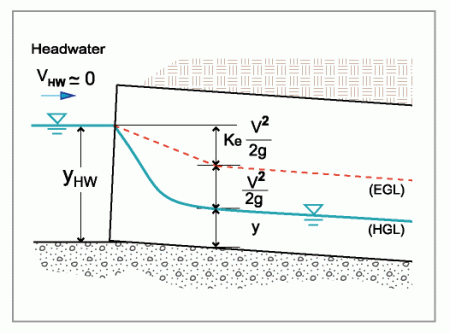Headwater Calculations |
The depth of water above the culvert inlet bottom is known as the Headwater Depth. This depth represents the amount of energy available to convey water through the culvert. Headwater depths are a function of the entrance shape, along with the depth and velocity immediately inside the culvert.

Headwater depths are determined by summing the energy losses associated with entrance shape, exit expansion and friction of the culvert. This is described in the basic energy balance equation:

Where:
Y = Depth (ft, m)
V = Velocity (ft/s, m/s)
DZ = Change in elevation (ft,m)
TW = Tailwater
HW = Headwater
g = Accceleration due to gravity (ft/s2)
In most cases the approach velocity (V) is low and the approach velocity head is neglected. Similarly the exit velocity can be neglected in the energy equation if the upstream and downstream channels are similar, reducing the Headwater calculation to:

where yHW is the sum of all losses and represents the difference in water surface elevation at the Outlet (headwater) and outlet (tailwater) FishXing does not include bend losses, junction losses, or grate losses.
Entrance Loss depends on the geometry of the inlet. This loss is expressed as the velocity head immediately inside the culvert reduced by the entrance loss coefficient, Ke.

Where:
HL = Head Loss (ft)
Ke = Entrance Loss Coefficient
V = Velocity in the culvert barrel (ft/s)
g = Acceleration due to gravity
FishXing calculates the headwater depth using the following Equation:

FishXing calculates total headloss as the sum of the Entrance Loss, Exit Loss, and Friction Loss.
Note: High exit velocities can cause downstream scour and present a barrier to fish passage so Exit Velocity should be considered in the design of culverts.